5 days Writing Challenge - Meet a genius: Santiago Calatrava
.jpg)
Santiago Calatrava in 2010 source
Santiago Calatrava Valls (born July 28, 1951) is a Spanish architect, structural engineer, sculptor, and painter who is most known for his single leaning pylon bridges, as well as his railway stations, stadiums, and museums, all of which have sculptural forms that mimic living beings. The Olympic Sports Complex in Athens, the Milwaukee Art Museum, the Turning Torso tower in Malmö, Sweden, the World Trade Center Transportation Hub in New York City, the Auditorio de Tenerife in Santa Cruz de Tenerife, the Margaret Hunt Hill Bridge in Dallas, Texas, and his largest project, the City of Arts and Sciences and Opera House in Valencia, are among his most well-known works. His practice comprises offices in New York City, Doha, and Zürich.
Early Life
In Valencia, he attended primary and secondary school before enrolling in the School of Applied Art in 1957 to study drawing and painting. He went to France as an exchange student in 1964, when General Francisco Franco’s rule was beginning to soften and Spain was becoming more accessible to the rest of Europe. He went to study at the Ecole des Beaux Arts in Paris after finishing secondary school in 1968, but he came in the midst of student riots and upheaval in the city.
He enrolled in the Valencia Polytechnic University's Higher School of Architecture. After receiving his architect's diploma, he pursued further studies in urbanization.
He performed individual projects with fellow students at the university and published two volumes on Valencian and Ibizan traditional architecture.
In 1975, he began a second degree in civil engineering at the Swiss Federal Institute of Technology in Zürich, Switzerland. After completing his thesis on “The Pliability of three-dimensional Structures,” he was awarded a doctorate in architecture in 1981.
Calatrava told writer Philip Jodidio of this time, “The impulse to start all over from zero was very powerful in me.” I was dead set on putting everything I’d learnt in architecture school aside and learning to draw and think like an engineer. I was enthralled by the concept of gravity, and I was persuaded that I needed to start with simple forms.”
Calatrava claimed that his work was influenced by the early twentieth-century Swiss engineer Robert Maillart (1872–1940), who taught him that “you may produce emotion with a sufficient combination of power and mass.”
Projects
Finally, in 1983, he began to receive commissions for larger industrial and transportation structures; he designed and built the Entrepôt Jakem, a warehouse in Münchwilen, Thurgau, Switzerland, another warehouse in Coesfeld-Lette, Germany, an addition to the main post office in Lucerne, Switzerland; a bus shelter in Saint-Gall, Switzerland (1983–85); the roof of a school in Wohlen, Switzerland (1983–88); and a bus shelter in Saint-Gall,Switzerland (1983–85) the roof of a school in Wohlen, Switzerland (1983–88). Then there were some large projects, including a new hall for the Lucerne railway station (1983–89) and a complete train station, the Zürich Stadelhofen railway station in Switzerland (1983–1990).
The train station boasts various aspects that have become hallmarks of his work, such as straight lines and right angles, which are uncommon in his work. The railroad platforms curve, the supporting columns lean, and teardrop-shaped skylights pierce the concrete walls of the modernistic cavern beneath the tracks. Tilting glass panels provide light and shelter without enclosing the platforms.
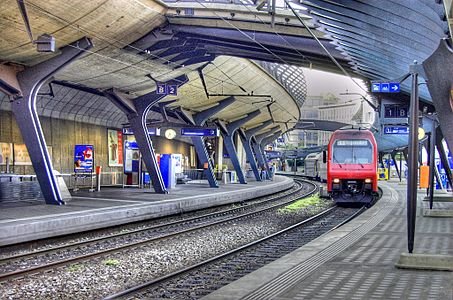 Zürich Stadelhofen railway station in Zürich. Switzerland (1983–90)
Zürich Stadelhofen railway station in Zürich. Switzerland (1983–90)
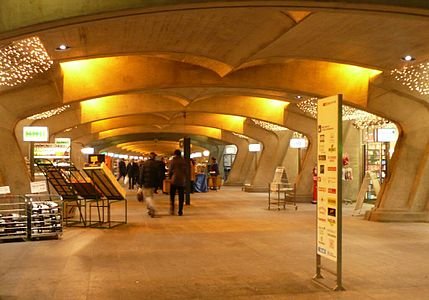 Interior of the Zürich Stadelhofen railway station in Zürich. Switzerland (1983–90)
Interior of the Zürich Stadelhofen railway station in Zürich. Switzerland (1983–90)
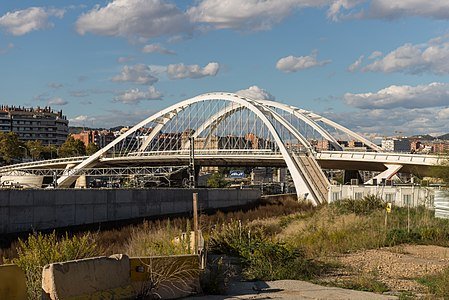 The Bac de Roda Bridge in Barcelona, Spain (1984–87): Calatrava's first bridge.
The Bac de Roda Bridge in Barcelona, Spain (1984–87): Calatrava's first bridge.
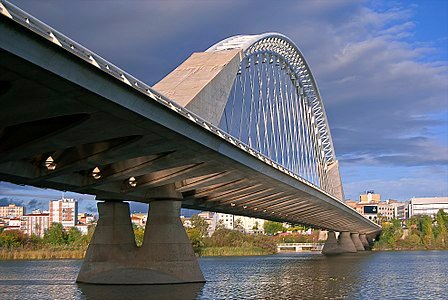 Lusitania Bridge, Mérida, Spain (1988–91)
Lusitania Bridge, Mérida, Spain (1988–91)
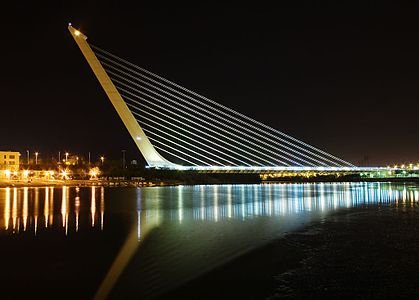
Puente del Alamillo Expo 92, Seville, Spain (1992)
He completed his first bridge, the Bac de Roda Bridge in Barcelona, Spain, in 1984–87, which garnered him international attention for the first time.
The bridge connects two sides of the city by over a wasteland of railway tracks, and is built for bikes and pedestrians. It’s 128 meters (420 feet) long, with twin arches that lean at a thirty-degree angle, a characteristic that rapidly became Calatrava’s distinctive style. The steel arches and cables that make up the upper portion of the bridge are light and airy, like a network of lace, yet are anchored to the huge concrete supports and granite pillars below.
His next bridge, the Puente del Alamillo in Seville, Spain (1987–1992), was even more spectacular and cemented his reputation. It is 200 meters (660 feet) long and crosses the Meandro San Jeronimo River.
It was built as part of Expo 92 in 1992. Its main feature is a single pylon 142 meters (466 feet) tall that leans to 58 degrees, the same angle as Egypt’s Great Pyramid of Giza. The weight of the pylon’s concrete is sufficient to support the bridge with only thirteen pairs of cables, obviating the need for any cables behind it.
Private Life
Why I chose Santiago Calatrava
Calatrava’s technical innovation, material superposition, and organic designs all help to make him a recognizable, personal, admired, and debated architect with his followers and critics all over the world, all of whom help to prove the importance of his work in modern design.
His Ground Zero projects in New York, the Turning Torso skyscraper in Malmo (Sweden), and a more than 600-meter-tall skyscraper project in Chicago all demonstrate his inventiveness. His bridge over Venice’s Grand Canal is an example of the discussions and debates that this one-of-a-kind artist is capable of generating. Santiago Calatrava is a controversial, criticized, and award-winning figure who will never be forgotten.
Indeed great people exist on earth with outstanding qualities to emulate from. A job well done for the time you put in your work. I’m inspired.
Thank you Bro for reading my post, as someone in the field of architecture; that man inspires me.
What a great man and a wonderful write up.. keep it up
Best of wishes Boss, thanks for the heads up.
Wow....
Indeed there are great men in this works that I haven't even heard about. Your choose genius is quite a great man and he really made a great impact with his bridge he made
Good luck on the contest
Wow, I didn't know that this man has done incredible things like this, he is successful.
We have supported this post. Keep on making great content in our community. Always check @steemalive for community updates. Thank you being an active member.